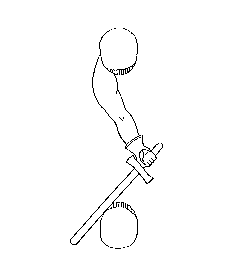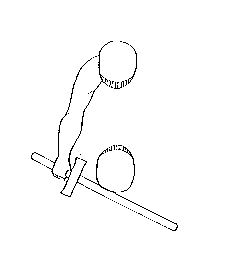|
|
|
Seventeen years ago, on the East coast, offense was very primitive. Circular blows were the rage. Fights sometimes looked like some sort of martial semaphore gone berserk. There were rumors from the West of blows that flashed like lightning and hit like thunder.
At Pennsic VI, several Western fighters of renown and fame came to Pennsic. They included Duke Paul of Bellatrix, Duke Henrik of Havn, Duke William of Houghton, Earl Kevin Peregryn, Viscount (then) Gregory of York and several others of skill and prowess. Duke Paul (and the others) held classes and demonstrations and they were most chivalrously available to one and all. Fighting in the Middle and East changed rapidly thereafter. Judging from Pennsic, for the last decade or so fighting skill has reached parity throughout the Knowne Worlde with each Kingdom retaining some local character.
After mastering the basic blow, blows to other targets are learned. But the basic blow is part of every blow. Do the basic blow, but stop when your elbow is beside your swordside ear. Learn this point well. EVERY BLOW PASSES THIS POINT. It is called the "decision point."
So what? If every blow looks the same until very late in the blow, your opponent has less time to react . . . a lot less time. This is a good thing if the object is to hit him. From this position (the decision point -- sword against the swordside ear), you can hit every legal target.
I divide all blows into forward blows and return blows. First, we'll discuss forward blows.
Every time you throw a blow, you use the mechanics of the basic blow until the decision point (elbow in the swordside ear). The blow's target is then decided by your elbow, forearm, and wrist. Forward blows are blows driven by the swordside hip coming forward. Like all other blows, the arm is fully extended and then the sword is fully returned.
To throw a forward blow at your opponent's leg, drive your elbow into your ribs while curling your wrist palmside up toward your shoulder.
To throw a blow at your opponent's helm on your shieldside (called the offside), after passing the decision point, elbow yourself in the chest just under your chin, and extend your arm fully. This blow can either clear the shield parallel to its top or the sword hand can travel high with the tip dropping over the shield and into the opponent's faceplate.
Some forward blows are thrown palmside down. For these blows, as the sword passes over the head while coming forward, the sword's point passes over the shieldside shoulder. It passes over the helm directly above it and parallel to the ground. Then blows may be delivered to the faceplate horizontally or the chest vertically.
Forward blows are power blows. They are the basis of most speed styles of sword and shield. For these blows, it is best to keep the hand and wrist stiff and unbent. Power is best transmitted this way. This kind of blow is more like a punch than like a whip. You keep your hand, wrist, and forearm locked and stiff to absorb less force. If you bend your wrist it acts as a shock absorber and you'd often prefer to shock your foe. The less force absorbed by the attacking fighter the better.

I have never done forward blows well.
I do, however, have quite a repertoire of return blows.
Return blows are blows driven by the swordside hip returning to stance. Their beginning is the basic sword blow to the decision point. Then the elbow and wrist determine placement. Return blows are typically delivered by turning the wrist so that the palm is facing down.
To hit the back of the head, throw the basic blow past the head. Instead of letting the hand drop, as the hips start to pull back synchronize the turning of the wrist palm down to the twisting of the hips. With your hips and shoulder, pull the sword blade through your opponent's head from back to front.

To hit the leg, after the decision point throw the elbow into the ribs as the swordside hip comes forward, and then synchronize the turning of the palm down and returning hip action. This blow will land on both cheeks if done perfectly. But it is easy to hit the knee or below doing this blow so extra care must be taken. To avoid hitting low I make sure that I pull my knuckles up back towards my elbow. The tendency, especially when tired, is to throw the blow flat; the flatter the blow the more likely you are to hit the knee and below.
To hit the center of the helm behind the opponent's head, throw the swordside hand straight up as the swordside hip comes forward, as the swordside hip returns turn the hand over 180 degrees.
The important suppression blow used during a retreat is also a return blow. With the swordside hip forward and the swordside hand anywhere, pull the elbow directly back. The sword should, almost of its own volition, describe an arc which cuts through the top of your enemy's helm right through the center.
The return blows have several wonderful characteristics. Often, their flight paths allow the fighter standing in A to ignore his opponent's shield. If the opponent's shield is open and against your chest, your swordside shoulder is free and able to direct the sword past the shield. The situation is even better if his shield is closed against his own chest or swordside shoulder.
Which brings us to the subject of movement and offense. Remember, in my system of stepping, we take small steps close to the ground. Our hips do not move when we walk. So we can throw a blow whenever our swordside foot is on the ground. This occurs twice in any step, as well as when we are at rest before and after movement. We can throw a blow whenever we wish. The advanced fighter can also pattern his attack to occur as his feet land. For instance, many fighters synchronize the initial movements of the sword blow with the instant the shield foot lands when regaining stance.
Now on to combinations. Hips. Remember hips? Our hips go forward and then return. If only we had blows that went forward and then blows that returned. What the hey! With practice, you will be able to let the motions of the basic sword blow repeat over and over again fluidly. This is called pistoning. Pistoning is the basis for combinations.
Pistoning is not moving your arms back and forth. In sword and shield, we piston with the hips. The hips drive everything. Throwing your arms back and forth without being driven by the hips is wrong.
Try this: Throw a basic sword blow to the (imaginary) foe's shieldside temple. Now, instead of returning it back to your shoulder, transform your return into a return leg blow by dropping your sword hand and turning it as the swordside hip returns. Then, pushing off with the interior of the swordside foot, throw your elbow high into your chest and hit your opponent in the forehead (with luck his shield is still down around his knees).
See how each blow blends into the next in a seamless fluid motion. It's
more difficult against a real fighter, but with practice sometimes it isn't.
The number of possible combinations is limitless. Each fighter's favorite
combinations will differ, but the principle is ever the same. Combine forward
blows and return blows with the pistoning of your hips.
Continue to Chapter 9